Chapter: 12th Physics : Magnetism and Magnetic Effects of Electric Current
Classification of Magnetic Materials
CLASSIFICATION OF MAGNETIC MATERIALS
The magnetic materials
are generally classified into three types based on the behaviour of materials
in a magnetising field. They are diamagnetic, paramagnetic and ferromagnetic
materials which are dealt with in this section.
(a) Diamagnetic materials
The orbital motion of
electrons around the nucleus produces a magnetic field perpendicular to the
plane of the orbit. Thus each electron orbit has finite orbital magnetic dipole
moment. Since the orbital planes are oriented in random manner, the vector sum
of magnetic moments is zero and there is no resultant magnetic moment for each
atom.
In the presence of an
external magnetic field, some electrons are speeded up and some are slowed
down. The electrons whose moments were anti-parallel are speeded up according
to Lenz’s law and this produces an induced magnetic moment in a direction
opposite to the field. The induced moment disappears as soon as the external
field is removed.
When placed in a
non-uniform magnetic field, the interaction between induced magnetic moment and
the external field creates a force which tends to move the material from
stronger part to weaker part of the external field. It means that diamagnetic
material is repelled by the field.
This action is called
diamagnetic action and such materials are known as diamagnetic materials.
Examples: Bismuth, Copper and Water etc.
The properties of
diamagnetic materials are
i.
Magnetic susceptibility is negative.
ii.
Relative permeability is slightly less than unity.
iii.
The magnetic field lines are repelled or expelled by diamagnetic
materials when placed in a magnetic field.
iv.
Susceptibility is nearly temperature independent.
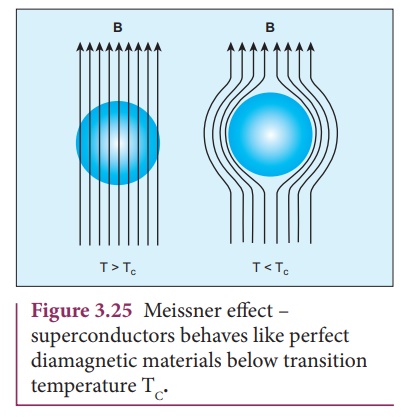
(b) Paramagnetic materials
In some magnetic
materials, each atom or molecule has net magnetic dipole moment which is the
vector sum of orbital and spin magnetic moments of electrons. Due to the random
orientation of these magnetic moments, the net magnetic moment of the materials
is zero.
In the presence of an
external magnetic field, the torque acting on the atomic dipoles will align
them in the field direction. As a result, there is net magnetic dipole moment
induced in the direction of the applied field. The induced dipole moment is
present as long as the external field exists.
When placed in a
non-uniform magnetic field, the paramagnetic materials will have a tendency to
move from weaker to stronger part of the field. Materials which exhibit weak
magnetism in the direction of the applied field are known as paramagnetic
materials. Examples: Aluminium, Platinum and chromium etc.
The properties of
paramagnetic materials are:
i.Magnetic susceptibility is positive and small.
ii.Relative permeability is
greater than unity.
iii.The magnetic field lines
are attracted into the paramagnetic materials when placed in a magnetic field.
iv.Susceptibility is
inversely proportional to temperature.
Curie’s law
When temperature is
increased, thermal vibration will upset the alignment of magnetic dipole
moments. Therefore, the magnetic susceptibility decreases with increase in
temperature. In many cases, the susceptibility of the materials is

This relation is called
Curie’s law. Here C is called Curie constant and temperature T is in kelvin.
The graph drawn between magnetic susceptibility and temperature is shown in
Figure 3.26, which is a rectangular hyperbola.
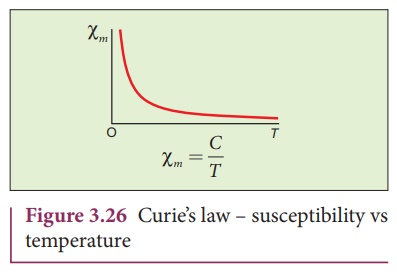
(c)Ferromagnetic materials
An atom or a molecule in
a ferromagnetic material possesses net magnetic dipole moment as in a
paramagnetic material. A ferromagnetic material is made up of smaller regions,
called ferromagnetic domain (Figure 3.27). Within each domain, the magnetic
moments are spontaneously aligned in a direction. This alignment is caused by
strong interaction arising from electron spin which depends on the inter-atomic
distance. Each domain has net magnetisation in a direction. However the
direction of magnetisation varies from domain to domain and thus net
magnetisation of the specimen is zero.
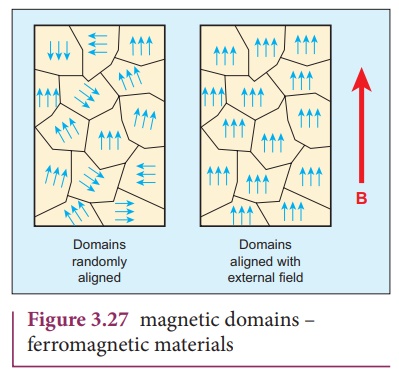
In the presence of
external magnetic field, two processes take place
1. the domains having magnetic
moments parallel to the field grow in size
2. the other domains (not
parallel to field) are rotated so that they are aligned with the field.
As a result of these
mechanisms, there is a strong net magnetisation of the material in the
direction of the applied field (Figure 3.28).

When placed in a
non-uniform magnetic field, the ferromagnetic materials will have a strong
tendency to move from weaker to stronger part of the field. Materials which
exhibit strong magnetism in the direction of applied field are called
ferromagnetic materials. Examples: Iron, Nickel and Cobalt.
The properties of
ferromagnetic materials are:
i.Magnetic susceptibility is positive and large.
ii.Relative permeability is
large.
iii.The magnetic field lines
are strongly attracted into the ferromagnetic materials when placed in a
magnetic field.
iv.Susceptibility is
inversely proportional to temperature.
Curie-Weiss law
As temperature
increases, the ferromagnetism decreases due to the increased thermal agitation
of the atomic dipoles. At a particular temperature, ferromagnetic
material becomes paramagnetic. This temperature is known as Curie temperature TC
. The susceptibility of the material above the Curie temperature is given by

This relation is called
Curie-Weiss law. The constant C is called Curie constant and temperature T is
in kelvin. A plot of magnetic susceptibility with temperature is as shown in
Figure 3.29.
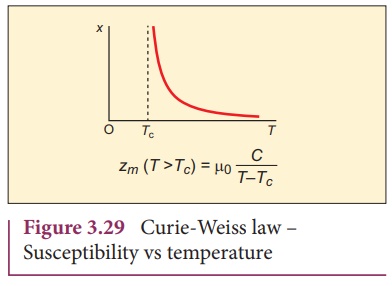
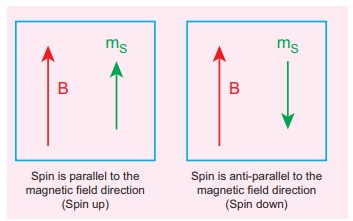

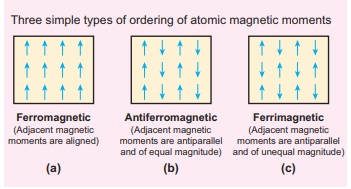
Related Topics